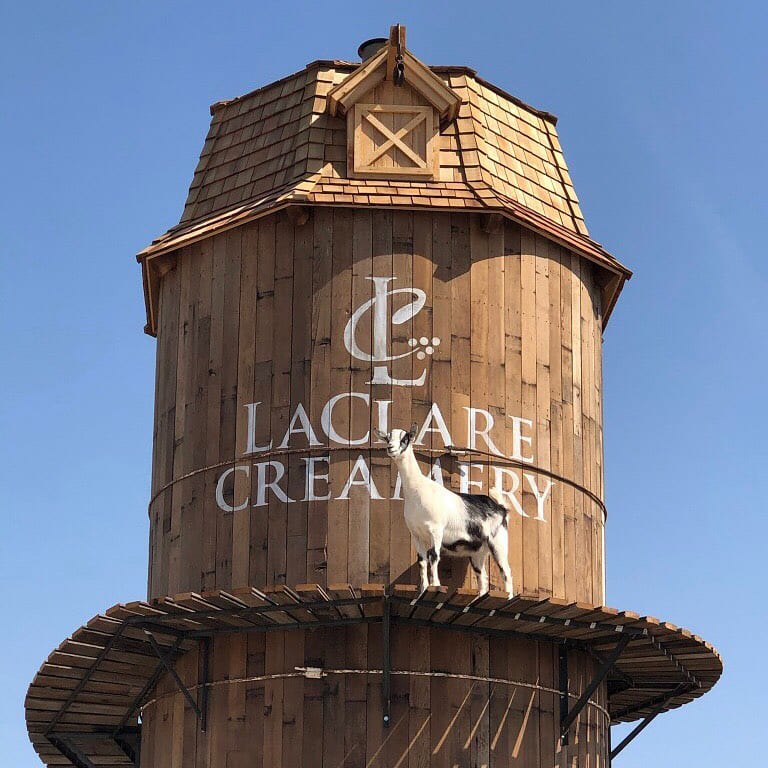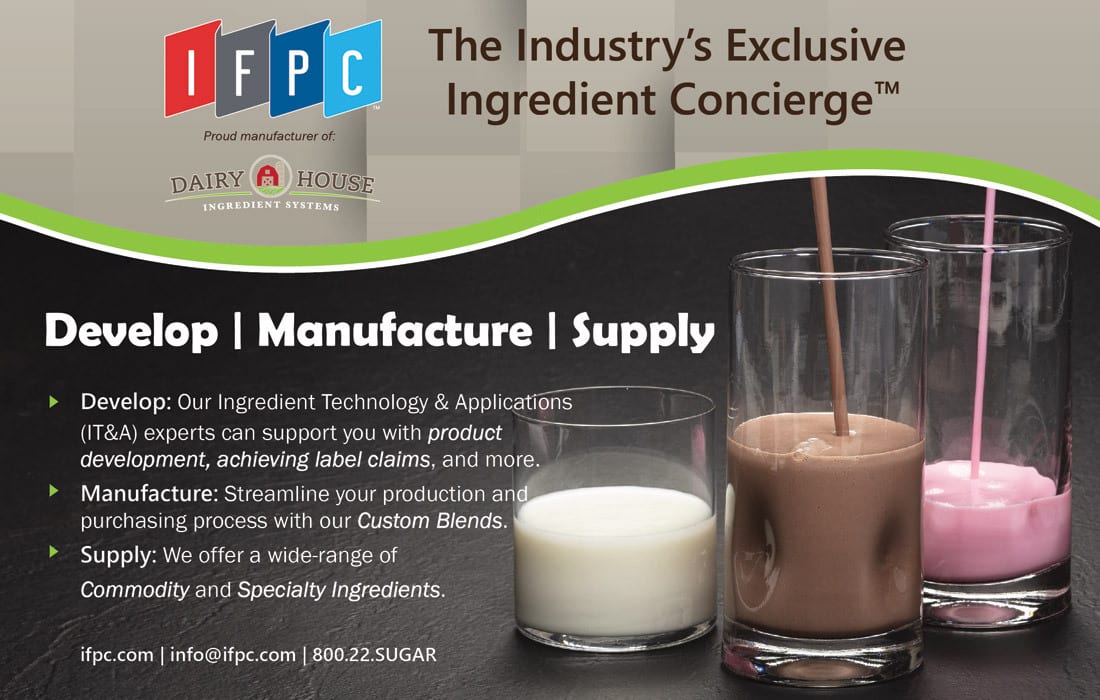INSIDE THE PLANT
The power of goats
“The majority of our goat milk is coming from goat dairies the Creamery owns, many of which are located within a 10-mile radius of our Visitor Center, Cheese Shoppe and cheese processing plant,” Coenen tells Dairy Foods during a plant tour. “This allows us to work with the freshest and cleanest ingredient and then add in our unique flavors. We have a lot of different SKUs we run through this plant, everything from hard cow and hard goat cheeses, to our award-winning soft chèvre cheese.
“There’s 60 SKUs, a lot of sizes and a lot of flavors. For sizes on the chèvre goat cheese, we go from a 1-ounce medallion all the way up to a 20-pound bag with the 4-ounce being the most popular retail size. On hard cheese, we do a 40-pound block all the way down to a six-ounce block,” he continues. “My favorite flavor is our Original chèvre because it highlights the cleanness of our milk. We have sweet flavors like Fig & Honey, savory flavors like Garlic & Herb, and umami flavors like Truffle. The great thing about our SKUs and the flexibility of our plant is that we’re able to produce something for everyone to enjoy.”
While the taste of goat’s milk and cow’s milk are similar, Coenen points out that some people who may have trouble digesting cow’s milk may be able to more easily consume goat milk products, including milk, cheese, butter, ice cream and yogurt.
Goat milk has the protein Alpha S2 casein, which is not an allergen, the USDA states. Additionally, goat milk packs a powerful protein punch. Compared to standard cow milk, soy milk or nut milks, goat milk has more protein per serving. It also contains significantly more protein than almond milk or rice milk, and the protein in goat milk appears to be more digestible, according to the USDA.
With several thousand goats owned by LaClare Creamery that are feeding and browsing at three sites, the Malone, Wis.-based brand is “milking the competition” as it utilizes a 41,000-square-foot processing plant to produce 6 million pounds of cheese annually.
Under the guidance and leadership of LaClare Creamery President Alex Coenen and a dedicated team of 55 plant employees, the biggest source of pride for the artisan cheese manufacturer is that it only sources 100% domestically available milk from local farms via the Quality Dairy Goat Producers Cooperative of Wisconsin.
When making artisanal cheese, the lion’s share of the milk used — 10 pounds of milk to produce 1 pound of cheese — comes from 1.27 million dairy cows in Wisconsin. Yet, in 2023, America’s Dairyland led the nation with 72,000 dairy goats, according to the United States Department of Agriculture (USDA).
In their prime and depending on breed, many dairy goats, which start milking at 85 pounds, can produce 6 to 8 pounds (3 to 5 quarts) of milk per day, the USDA reports.
By Barbara Harfmann, Managing Editor
LaClare Creamery supports nationwide distribution with expanded dairy plant.
The power of goats
“My favorite flavor is our original chèvre because it highlights the cleanness of our milk. …The great thing about our 60 SKUs and the flexibility of our plant is that we’re able to produce something for everyone to enjoy.”
— Alex Coenen, president, LaClare Creamery

Fostering a farm-to-plate connection
Founded in 1978 as a hobby farm with just two goats, LaClare Creamery’s name originates from the first names of its founders, Larry and Clara Hedrich. Entering its 46th year, it doesn’t take a large herd to draw people to LaClare’s expanded processing plant, retail shop, café, garden center and goat farm that has 700 goats, or doelings, onsite.
“Goats are curious by nature, and they’re super fun to watch. We were out there today, and they loved walking up to us to nibble on our clothes and take pictures with us,” Coenen notes. “There’s a real connection between goats and people. The reason we centered our Visitor Center around our animals is, first off, we get to show our care for the animals, and, second, we are fostering a farm-to-plate connection with where our food is coming from.”
Throughout the year, the creamery hosts a wide variety of fun, educational events that enable “kids” of all ages to bottle-feed kid goats, enjoy snuggles and pajama time, or in honor of the Super Bowl, come dressed in a favorite team’s jersey to receive a free scoop of ice cream made from cow or goat milk and see baby goats dressed up as little football players.
Headquartered at W2994 County Road HH in Fond du Lac County, Wis., LaClare Creamery is a go-to, family-friendly destination that annually welcomes 130,000 visitors. There’s also a viewing window of the cheese processing plant to give consumers a closeup look at how goat cheese is made.
“It helps our cheesemaking process by starting with something great, fresh and clean — our milk,” Coenen stresses. “We keep our processes very streamlined and simple, always to make sure that we’re treating the product with the utmost care.”
Coenen explains that the Creamery’s hard cheese processing began in 2012 along with the opening of the Café and Visitor Center, while its soft cheese operations began in 2017 with the purchase of chèvre-making equipment from Newark, Mo.-based Heartland Creamery.
“In 2017, we got our soft goat cheese equipment from Heartland and in 2019, we underwent an expansion in the space we’re sitting in to keep up with demand for our chèvre,” he explains. “From there, we're working on filling the footprint because we built to make sure we have room to grow and further expand.”
Located on the Creamery’s first floor, the 41,000-square-foot cheesemaking plant churns out 20,000 pounds a day of hard and aged goat cheese in 10 styles — including Cheddar, award-winning Evalon, Feta, PepperJack and Mozzarella.
Production wise, 80% of LaClare’s cheese are its award-winning chèvre, while 20% of operations are devoted to hard and aged goat cheese such as its Raw Goat Milk Cheddar, which is aged at least six months and is a nutty, sweet and fruity cheese sold in a 6-ounce package.
Additionally, two of the Creamery’s products are mixed milk cheeses. The cheddar-style Chandoka, which is aged four months, and the Cave Aged Chandoka, aged nine months, are fashioned using a blend of 70% cow milk and 30% goat milk to create unique flavor profiles with an earthy aroma, vegetable undertones and rich butter notes.
How to craft fromage de chèvre “goat cheese”
Hard goat cheese aside, what really sets LaClare apart and the crème da la crème of its product portfolio are its fresh, soft and spreadable goat cheeses, or chèvre, which is known as fromage de chèvre (“goat cheese”) in France.
The chèvre lineup includes flavors like the creamy, spicy and tangy Chipotle Honey; the creamy, sweet and tart Rolled Blueberry Vanilla; the sweet, fruity, spiced Apple Cinnamon and Cranberry Cinnamon; the sweet, fruity, tangy Maple Bourbon; the sweet, creamy and mild Fig & Honey; and more.
All the flavor varieties originate from the creamy, sweet and tangy Original. From 2018, when LaClare’s soft goat cheese line first debuted, through 2023, chèvre has captured 20 awards at local, state and world championship contests.
“We're going to keep iterating new flavors and keep innovating with it comes to our chèvre and make sure we can keep up with consumer trends and customer demand,” Coenen stresses.
He further suggests that making chèvre is “very similar” to hard cheeses that use cow’s milk.
“The main difference is how they are pressed,” he explains. “On the hard cheese side, they use large hydraulic presses in block form to get the curd to knit together. On the chèvre side, we use a softer pressing method where we use hanging cheesecloths with an open top that is filled with curd and whey. Over a period of six hours, that whey drains off and the curd is slowly pressed together with a lot less pressure. Once it hits the right moisture, it gets debagged and moved to our mixer.
“After the milk goes through intake and into the pasteurizer, it goes into large vats called maturation tanks, and it's going to sit in those tanks for 16 to 18 hours,” he continues. “In October we brought in a new, steel maturation vat that can hold 40,000 pounds. That’s where we add the cultures. It’s basically going to get curds and whey to a loose cottage cheese consistency. From there, it gets pumped over to our presses. The presses are an enclosed cheesecloth that has an opening at the top. The curds and milk go into those bags and over a process of around six hours, some of that whey is going to naturally fall through that cheesecloth to be collected. We actually sell that goat whey for other things like goat protein powders.
“Then they get pressed together with light pressure. Compared to the hard cheese side, which uses hydraulics, this process takes more time and is a gentler process, which fosters a bit more yield — 10 to one on the hard cheese side and about seven to one on the chèvre side. After the cheese gets to the right moisture content, we move it into a mixer where we add our salt and flavorings. From there it goes into a packaging line, we apply labels to both sides, and get it ready for the consumer.”
Coenen notes that every piece of equipment is vital to LaClare’s cheesemaking operations. “If our packaging line wasn’t there, we’d have open cheese,” he states. “If our extruder wasn’t there, we’d just have cheese in a mixer. If our mixer wasn’t there, it’d just be in a bag.”
During the year, the Creamery hosts a wide variety of fun, educational events that enable “kids” of all ages to bottle-feed baby goats, enjoy snuggles and pajama time and more.
A commitment to milk, cheese and people
Additionally, the quality of the goat milk and the team of 55 employees working in a split shift within the plant to care for that milk as it goes through every step is a never-ending pursuit.
“We really look at everything and say, ‘how can we get better? How can we streamline operations to get better?,’” Coenen asks. “In the dairy industry, everyone has challenges, and we’re no different. But we’re resilient and consistently working together to solve challenges and share new ideas.”
The president shares that during an onsite visit from a large customer, they were impressed that “there weren’t any operational issues from us during the pandemic. That makes me so proud,” he says. “One thing we measure is perfect order performance, so every line on every PO (purchase order) is filled.
“We have a great team who really puts the customer first and we want to make sure that we’re the dairy company people want to do business with,” Coenen concludes. “We’re growing, we love what we’re doing, and we’re transparent about our milk, our people and our cheese. My philosophy is that if you’re meeting all the goals in your strategic plan, then your goals aren’t set high enough. We keep pushing forward.” DF
Wisconsin boasts the highest concentration of dairy goat farming in the nation. LaClare Creamery goats are milked twice a day with the majority of milk coming from goat farms within a 10-mile radius of its headquarters.
Article photos by Barbara Harfmann.

